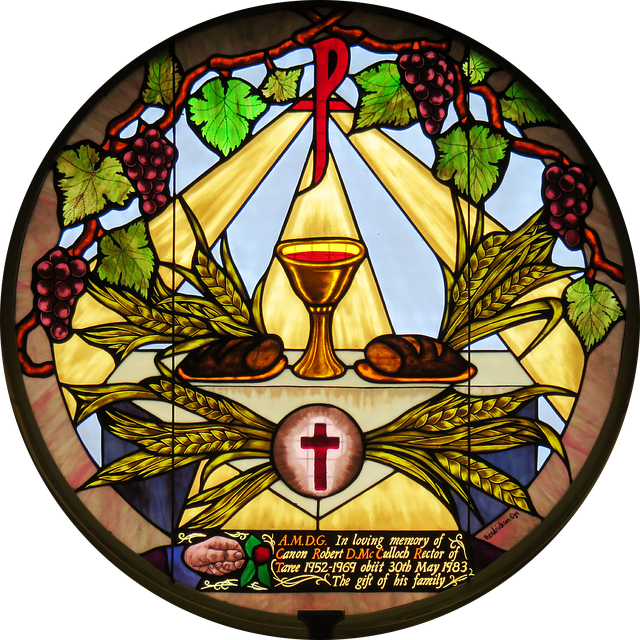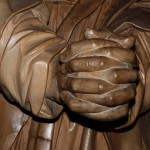Thesis
Jesus is the Good Shepherd. In fact, he is the Shepherd for whom Israel had been waiting (Ezekiel 34). The resurrection of the Son of God means that he is living and actively guarding his sheep and shepherding their hearts toward him. To dig into the nuts and bolts of this passage from a pastoral angle it is important to understand the role of both shepherd and sheep.
My friend, Margaret Feinberg, wrote a book called Scouting the Divine in which she explored the agricultural and agrarian themes of the Bible that might be lost on most of the western world. Margaret spends time with a shepherdess from Oregon and provides excellent insight into this important biblical theme—go read it!
Analysis
Collect
O God, whose Son Jesus is the good shepherd of your people: Grant that when we hear his voice we may know him who calls us each by name, and follow where he leads; who, with you and the Holy Spirit, lives and reigns, one God, for ever and ever. Amen.
The collect highlights three distinctive features of the shepherd-sheep relationship. First, Jesus is the shepherd and therefore we are the sheep. Simplistic but important. We should never forget that Jesus is the one who leads his people.
Second, we are called to hear and recognize his voice. To hear his voice is the first step but it is not enough. I may hear the sirens blaring behind me (I haven’t been pulled over in years!) but if I do not recognize that the sirens are a police car urging (commanding) me to pull over then my auditory skill means nothing.
Third, we are called to follow. To hear and recognize the voice of the shepherd should always result in following. Once I’ve discerned the police siren and understood that it was directed at me, I am left with a choice: pull over or run for it. It’s an imperfect analogy but it still works on some level. Bonheoffer suggested that discipleship is rather simple: Jesus calls and we follow. But why do we follow? We follow because we know the one who is calling us. That’s the point here! We’re not following a stranger; we are following the good shepherd! The lessons for this Sunday provide a beautiful picture of the Good Shepherd.
First Reading – Acts 4:5-12
Peter and John have been arrested. Why? Because they preached Jesus and the resurrection! The resurrection is both folly and scandalous to those who do not yet know Jesus. This is the second time in as many chapters that Peter has been at the center of a controversy due to a healing miracle.
Peter’s response to his accusers is quite simple—and it echoes what he said in chapter 3 after that healing episode. He says: “the power to heal comes from Jesus of Nazareth; you crucified him; he’s been raised from the dead; he is the one way to salvation.”
Look at the lessons for Easter 3 and read my summary of Acts 3 here to see more on the same point. Peter has a basic message and formula for sharing the Good News with those around him: Jesus, crucified and risen. There is nothing fancy or flashy about his words or technique—its just Jesus.
Peter roots Jesus firmly in the history and tradition of Israel. This is something that Paul and the other New Testament writers did on a routine basis—read N. T. Wright and Richard Hays for more on this—because Jesus was an actual person who walked this earth and who inhabited and embodied an ongoing story. The Old Testament (as we know it) was the interpretive matrix for the Gospels. Here is a long excerpt from something I wrote several months ago on the topic:
A helpful methodology, according to Hays, is that we learn to read backwards. He believes the Old Testament to be the “interpretive matrix” for the fourfold Gospel.
Hays’ view, which he expounds on in much of his writing, celebrates that Jesus of Nazareth was a Jew, that he lived within a very Jewish context, and that the stories of Israel were his own. Further, to fully understand the many claims of Jesus as recorded in the gospels one needs to understand the story from which they were launched. For example: Israel was waiting for Messiah and many believed that the Anointed One would be a political and/or military type leader, and yet this was not who Jesus was. Instead Jesus was the Suffering Son of Man and the only way to grasp such a concept is to be aware of the “Son of Man” motif in Daniel and the Suffering Servant in Isaiah.
Rather than reading the New Testament into the Old, or “searching for Jesus” within Israel’s Scriptures, we are challenged to embrace these writings as our own corporate memory just as we’ve been adopted into Jesse’s branch. This has all sorts of ramifications for preaching and discipleship. One is a call to radical discipleship and an authentic engagement with culture. To read Scripture well is to begin living Scripture daily and publicly, it is to engage with a world desperately in need of the triune God, and it is to occupy space in the here and now according to Jesus’ vision for life. The faithful presence that Hays sees for every Christian begins with understanding the story of Jesus through the lens of Israel and then embodying Jesus’ kingdom presently.
By referencing the stone rejected by the builders, Peter is placing Jesus squarely in the salvation history of Israel and verbally recognizing him as the Faithful Israelite.
Psalm 23
The 23rd Psalm was penned by the shepherd-king and is about the Shepherd-King. David’s own context is important when understanding the imagery contained inside: it’s not just poetic; it’s utterly accurate.
The entire Psalm hinges upon the opening five words: the LORD is my shepherd. Everything else in this Psalm is totally dependent upon this one phrase. You could literally insert this clause at the beginning of every verse like this…
Because the Lord is my shepherd…I shall be in want.
Because the Lord is my shepherd…he makes me lie down in green pastures.
Because the Lord is my shepherd…I shall not fear evil when I walk through the valley of the shadow of death.
Why? Because the LORD is a good shepherd. He cares for his sheep. Shepherds were known to defend their sheep against predators, to lead their flock to new grazing every day, and to care for them when they were in need—to literally go after the 1 when the 99 were safe. You can use Psalm 23 in a variety of ways but for the sermon this Sunday you should use it as a living picture of the shepherd’s goodness.
Epistle – 1 John 3:16-24
1 John 3 is a direct reference to John 10: we know this great love because Jesus laid down his life for us. He goes on to say that he has the power to lay his life down and pick it back up again. This is a radical love and radical love is always a call to action. If Jesus loves us so, how can we see a neighbor in need and refuse to help? If Jesus loves us so, how can we continue to consciously or unconsciously contribute to racism, sexism, ageism, or unfair economic structures in this world? If Jesus loves us so…then what?
John moves further into that call when he writes, “not in love or speech, but in truth and action.” Our heartfelt words are not enough; the language of grace is insufficient. Grace is sufficient, it is more than enough, but simply talking about grace will not do. We are called to love beyond boundaries, beyond borders, beyond our means and beyond ourselves. Why? Because he first loved us, even while we were still sinners. Love is therefore a response to God’s grace.
John further weaves together the tapestry of his gospel and epistle by making reference to abiding in Jesus. In John 15, Jesus talks about the vine and the branches and how the disciples are to abide in the Father’s love—this is the pericope for Easter 5 and 6—and here he draws the connection: to love God and one another is to abide.
The commandments are simple: believe in Jesus and love one another. I have written on this extensively and may post a paper or excerpt soon, but covenant faithfulness will always result in loving action. There are a myriad of situations not covered by Scripture explicitly but if we keep these two commandments in mind (love God and one another) then we will not have to wonder how we should act. As Dave Ramsey said, “When you live a life based on principle 99% of your decisions are already made.” The life of the disciple is the life of loving action.
Gospel – John 10:11-18
The Gospel lesson for Easter 4 is the crowning climax of the lectionary readings; it is pastoral, sacrificial and eschatological in nature. Before digging into John 10 it is important to set the stage, Jesus’ words, “I am the Good Shepherd” are not simply poetic, they are prophetic. Read through Ezekiel 34 and you’ll see what I’m talking about. Israel had been given spiritual shepherds who had abandoned their flock, feasted upon their charges, and who had abdicated any real spiritual authority. Such action sparked YHWH’s fury and he speaks through Ezekiel to say, “I myself will be the shepherd of my sheep.” He lists five main actions of the shepherd: seek the lost, bring back the strays, strengthen the weak, heal the sick and bind up the injured. This was a promise, not a threat and so when Jesus speaks these words it is the fulfillment of that which YHWH has promised his people: he will be their shepherd.
Our passage comes on the heels of Jesus’ opening remarks about being the sheep’s gate—all who enter the pen must pass through him. “I am the Good Shepherd,” he begins. Our 8 verses cover in depth what it means for him to be the True Shepherd of Israel. Here are the highlights:
- Lays down his life for his sheep, unlike the hired hand
- Shepherd knows his own and his own know him just as he knows the Father and the Father knows him
- Makes one flock out of many
- Has the power to lay down his life and take it up again
- This command has come from the Father
There is a lot that can be covered given these points, but let us briefly unpack them. Jesus is going to lay down his life for his sheep. We hear later in the Gospel that “no greater love has a man than this, that he lay down his life for his friends.” It was common for shepherds to have their sheep sleep in caves and to lay down across the small opening. This way nothing could come in without first going through the shepherd; this is why he is both gate and shepherd. The hired hand would not do this because he isn’t invested in the sheep like the shepherd is.
The shepherd knows his sheep. Margaret does a brilliant job of capturing the shepherdess in Oregon who can spot her sheep uniquely based on birth marks, the coarseness of their coat, or even the sound of their bleating. These are things that a shepherd notices and remembers, just as a parent does for a child. Jesus know us this way and is also known by the Father.
Jesus has sheep of another flock that will join this flock so there is one flock and one shepherd. Sounds like Paul in Ephesians 4, right? The point is the same! Israel and the church are to become the new Israel and there will be one people. Jesus’ followers are to be grafted into the branch of Jesse and embedded in YHWH’s history with Israel.
Jesus’ power to lay down his life and take it up again comes from his Father and it is something that he will demonstrate on the cross and through the empty tomb. Jesus traveled to the cross willingly, allowing himself to be betrayed, and his Father vindicated him victoriously as he trampled down death by death.
This is the image of the Good Shepherd. This is the image of the Risen Christ who is Lord over his flock. This is whom we worship as part of the triune God.
Liturgical Considerations
Consider juxtaposing this week (Easter 4) with Christ the King Sunday (last Sunday before Advent). John 10 is often used in both circumstances. The RCL does not include Peter’s reinstatement by Jesus (John 21) during Eastertide this year and so that’s another consideration to make. When John 10 comes up on Christ the King Sunday the question to “What type of King is Jesus?” becomes, “He’s the Shepherd-King.” When John 10 comes up in Eastertide the question can easily become, “What kind of Lord is Jesus?” The answer is obvious, “He’s the Shepherd-Lord.” Christ’s Lordship and his Kingship are interwoven an intertwined. You might think of grabbing the Collect for Christ the King Sunday (Almighty and everlasting God, whose will it is to restore all things in your well-beloved Son, the King of kings and Lord of lords: Mercifully grant that the peoples of the earth, divided and enslaved by sin, may be freed and brought together under his most gracious rule; who lives and reigns with you and the Holy Spirit, one God, now and for ever. Amen.) and using it at some point in your sermon.
I have penned an alternative proper preface for the Eucharist on Easter 4:
But chiefly are we bound to praise you for our Shepherd-King; for your Son Jesus Christ is both the true Paschal Lamb and the true Shepherd of Israel who has bound up the injured, healed the sick, strengthened the weak, sought out the lost, and brought back the strays. May we hear and recognize his voice for by his death and rising to life again we are able to have abundant life now.
Synthesis
I have often heard leaders (read: bishops) refer to themselves as “under-shepherds.” By this they mean that they are shepherding the flock on behalf of the Good Shepherd. I’ve also heard leaders suggest that we should look like sheep from the front and shepherds from the back. The point is the same in both instances: we are following the voice of the one and true shepherd of Israel, period. We are also called to lead others to the shepherd and therefore we take on the role of “under-shepherd” in a sense. Listen to the shepherd’s voice and help others to recognize it as well.
Major Request: Please do not use the tired idea that sheep are somehow stupid. Sheep are actually quite intelligent. However, sheep are in desperate need of a shepherd because they are vulnerable animals. There is a massive difference between being dumb and vulnerable. When Jesus described himself as the Good Shepherd—and when God promised to be Israel’s Shepherd—it was not a backhanded way of suggesting that the sheep were stupid. Can you imagine a more insulting promise? Then why do preachers constantly begin this sermon by suggesting, “Well, sheep are actually quite dumb because they fall and can’t get up; they don’t know how to graze for new food, etc. etc.”?
To follow Jesus as the Good Shepherd is to believe that he is both the crucified and risen one. To follow him is to love him and learn from him. We follow Jesus because he is our Shepherd and we desire others to follow him as well. This may mean that the sheep are actually following you while you are following Him, but always point people to Jesus.











